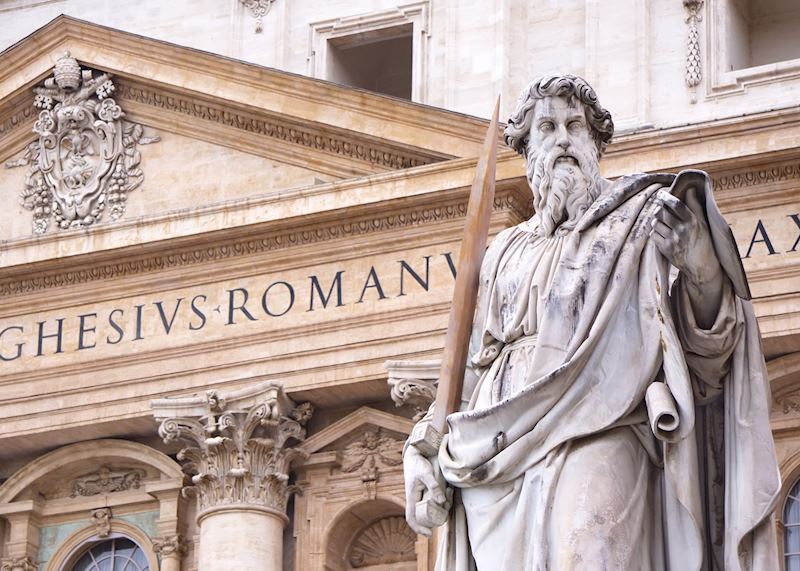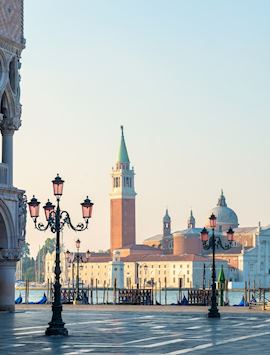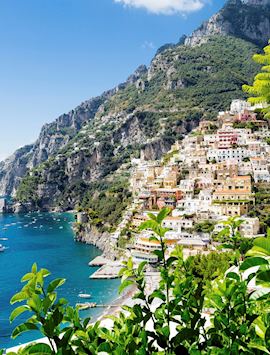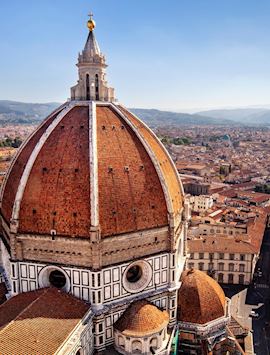By Italy specialist Cara
Though it’s the smallest country in the world — about an eighth the size of Central Park — Vatican City contains multitudes. There are few other destinations with such a density of history and art. I return every time I visit Rome and always find something new, whether it’s a hidden nook of the gardens or a Renaissance masterpiece tucked away in a corner.
The city is comprised of several areas open to the public: the museums, St. Peter’s Basilica, St. Peter’s Square, and the papal gardens, all surrounded by the towering walls that have protected the microstate for more than a millennium. Clearly, there’s a lot to see and do in Vatican City, but here are my top suggestions for your visit.
Choose your destination
1. Choose a private guide

Vatican City is a maze of 26 different museums, galleries, rooms, chapels, gardens, and crypts, each one packed with paintings, statues, murals, and relics. Add in the usual throngs and a visit on your own can be a bit overwhelming.
A privately guided tour serves several purposes. The museums display 20,000 pieces of art and antiquity spanning millennia and a guide can add context to everything you’re seeing, illuminating the otherwise-invisible history in every item, every hallway, even the architecture itself. (More on that below.)
They’ll also help you find what interests you. You might want to see just the highlights, or be interested in Baroque art, or want to delve deeply into the iconography of a specific saint. Your guide can ensure that you use your time wisely.
Finally, a guide can help you navigate the (sometimes thick) crowds that gather here. The Vatican’s historic design means that bottlenecks sometimes form, and they’ll help you deal with them.
2. Marvel at the Sistine Chapel

The single most popular thing to see in Vatican City is, of course, Michelangelo’s ceiling in the Sistine Chapel. Rendered in pigments that seem to glow with an inner light, the frescoes are painted masterpieces from an artist primarily known for his sculpture.
You can see his passion for human anatomy in the powerful lines of each of the figures in the panels. Creation of Adam is the best-known panel, but I also like the portraits of the sibyls, ancient soothsayers who are said to have foretold the coming of a messiah.
Talking, even whispering, is forbidden in the chapel itself but there’s a special fellowship that forms between you and all the other visitors standing silently, necks craned, gazing at the frescoes. Your guide can still provide context — they’ll take you out into the garden to see photos of the ceiling and provide an artistic interpretation there.
3. See the Raphael Rooms

Second only to the chapel are the Raphael Rooms, a series of small chambers that were painted by Raphael under Julius II. The best-known room is School of Athens, one of four frescoes depicting the four different schools of Renaissance thought: philosophy, theology, poetry, and justice.
Your guide will point out the ways that Michelangelo likely influenced Raphael’s style when it came to painting the figures — he was just a few doors away painting the chapel at the same time. However, the composition is purely Raphael’s own genius — I love the careful balance of the murals’ symbolism as well as its technical brilliance. And, of course, the luminous, translucent shades remain arresting, centuries after they were painted.
These rooms can get crowded — they were originally intended as private chambers for the pope rather than viewing galleries for the public. If you’re passionate about seeing these frescoes, I suggest timing your visit to the Vatican City carefully. That might mean a very early morning tour or a trip in winter or early spring, when crowds are less likely.
4. Gaze at Michelangelo’s Pietà

I’m not an expert on Renaissance art by any means, but even to me, Pietà stands out as a major milestone of Michelangelo’s works. Tucked into a niche in St. Peter’s Basilica, its intimate portrayal of grief is so exquisitely rendered that it’s usually the first thing I gravitate toward when I visit.
My guide pointed out the artist’s signature, which appears on a sash across the sculpted folds of Mary’s robes. Legend has it that he was so mortified by his outburst of pride that he never signed another work.
5. Send a postcard from the post office

As its own country, Vatican City operates a postal system, and I always take a moment to stop in and send a postcard when I visit. The stamps are particularly sought after by philatelists, I’ve been told.
You can buy postcards and stamps at one of the city’s many post offices — I counted at least four off St. Peter’s Square last time I was there. However, you can also send postcards or even letters you brought from outside.
Fill it out, affix your stamp, and drop it in one of the many drop-off boxes dotted around the city — they’re sunny yellow, for the most part, but you might see red or blue as well. Look for the words “Poste Vatican” on the outside.
6. Find your way to the Gallery of Maps

Commissioned by Pope Gregory XIII, the frescoes in the Gallery of Maps represent the most cutting-edge cartography of the late 1500s. Today, they’re often overlooked — bypassed for the flashier masterpieces — but I think they’re a fascinating window into the (literal) world view of the past.
Depicting the Italian peninsula, the murals are shockingly accurate for being almost five centuries old and drawn up with such early tools.
While the maps are impressive, don’t forget to look up, too. The heavily gilded ceiling contains painted works that directly relate to the corresponding map right beneath it. Your guide can explain the links, which are obscure for modern viewers.
A fun aside: about halfway down the gallery, you can glance out the window and see the tower for the Vatican’s radio station. Broadcasting in more than 40 languages, it’s maintained by the Jesuit order.
7. Take in the gardens

A leafy green oasis that takes up almost half the city’s footprint, this complex of interlocking gardens offers a serene pause in your tour. The crushed gravel paths wend between differently themed areas, including tidily trimmed knot hedges, romantically overgrown groves, and an ivy-covered replica of the grotto at Lourdes.
Dotted amid all the greenery are fountains, including one of a full galleon shooting jets of water instead of cannonballs. Many visitors skip the gardens, preferring to dive right into the museums, but I think they’re a vital stop.
8. Be impressed by Bernini
The artwork is, of course, dazzling, but the main event here is the basilica. This is the biggest and most ornate space I’ve ever been in — it’s the largest church in the world, after all — and the light-filled nave was deliberately designed to evoke awe and wonder.
The crown jewel of all this glory is the baldachin (canopy) that sits over the papal altar, which, itself, sits over the tomb of St. Peter. A Baroque masterpiece of bronze and gilt, its exuberant spiral columns and dynamic figures influenced church architecture for centuries to come.
Bernini also designed St. Peter’s Square, outside. The massive space has spent 500 years welcoming huge crowds to papal audiences.

9. Take Mass
St. Peter’s Basilica welcomes all visitors, regardless of faith, to Mass multiple times every day. You won’t need a ticket, but you will need to factor in the lengthy wait times for clearing security — at least one hour and often as much as three.
The service itself is held in Italian or Latin and you can even attend one in the Extraordinary Form (the more formal Mass liturgy, performed entirely in Church Latin, which was common before 1969). If you attend the Sunday morning service, and the pope is in residence, there’s a chance he’ll appear on the balcony outside his apartments to make a brief speech and offer a blessing at noon.
10. Climb the cupola

Built on a hill overlooking the river, the basilica commands a prime perch inside of Rome and it’s no wonder that you can get some of the best views of the city from here. There’s a separate entrance to climb to the cupola (also known as the Lantern) and the route up includes two levels.
I prefer to take an elevator to the first level, though of course there’s a wait to board, but if you like, you can brave the 300+ stairs. Inside, you’ll have a closer view of Michelangelo’s genius — he was the primary architect of the dome. The nave is so big that it can be hard to appreciate the dome from below.
Outside, the roof gives you exceptional views of Vatican City, including the gardens, the square, and the museum. You’ll also get a very close view of the colossal apostle statues that watch over the square below. It’s a good place to relax in the cafe, refill your water bottle, and generally gather your strength for the next leg of the journey.
The climb to the Lantern is more than 200 steps with the walls slanting ever inward as you climb higher. However, the steps are varied with wider spaces between the narrow sections, so you’ll have some breathing room. And the view from the top is incomparable.
11. Descend into the Necropolis
Tucked into the basement of the Vatican is the Necropolis, said to be home of the tomb of St. Peter himself. Located directly under the cupola and Bernini’s baldachin, the area is known in Italian language as scavi — excavation — because this is still a very active archaeological dig.
While the saint is the headliner, there are plenty of other tombs to see because this was once an open-air cemetery near the Circus of Nero. The sensitive nature of the sight means that photography is strictly forbidden. Additionally, the sometimes-lax dress code is sternly enforced, so be sure to wear clothing that covers your knees and shoulders.
Few visitors venture into these depths, a deliberate decision made by the Vatican to preserve the delicate historical sight. It’s a very small area, with narrow stairs and limited space. You’ll have to plan your trip well in advance to get the hard-to-come-by tickets. What’s more, changes in the Papal schedule and archaeological demands mean that tours are often canceled or moved at the last minute, so flexibility is key.
Read more about trips to Italy
Start thinking about your experience. These itineraries are simply suggestions for how you could enjoy some of the same experiences as our specialists. They're just for inspiration, because your trip will be created around your particular tastes.
View All Tours in Italy



